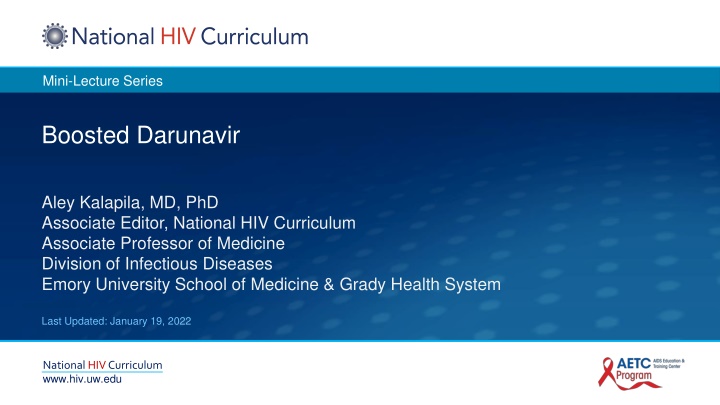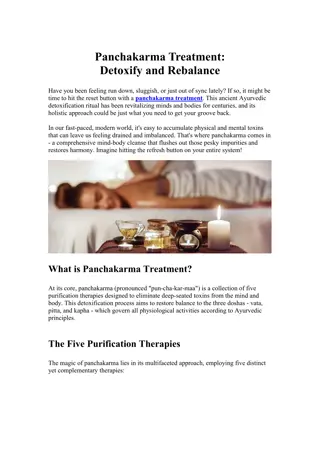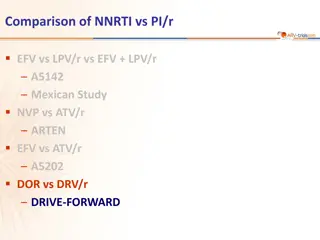
Boosted Darunavir: Dosage, Administration, and Considerations
Boosted darunavir, an oral protease inhibitor co-administered with ritonavir or cobicistat, is used in the treatment of HIV-1. This medication requires testing prior to initiation, considerations for renal and hepatic impairment, and specific dosing regimens based on patient history. Learn more about the basics and recommended dosing of boosted darunavir in adult patients.
Download Presentation

Please find below an Image/Link to download the presentation.
The content on the website is provided AS IS for your information and personal use only. It may not be sold, licensed, or shared on other websites without obtaining consent from the author. If you encounter any issues during the download, it is possible that the publisher has removed the file from their server.
You are allowed to download the files provided on this website for personal or commercial use, subject to the condition that they are used lawfully. All files are the property of their respective owners.
The content on the website is provided AS IS for your information and personal use only. It may not be sold, licensed, or shared on other websites without obtaining consent from the author.
E N D
Presentation Transcript
Mini-Lecture Series Boosted Darunavir Aley Kalapila, MD, PhD Associate Editor, National HIV Curriculum Associate Professor of Medicine Division of Infectious Diseases Emory University School of Medicine & Grady Health System Last Updated: January 19, 2022 National HIVCurriculum www.hiv.uw.edu
Disclosures Dr. Kalapila has no financial conflicts of interest or disclosures.
Boosted Darunavir Basics Medication - Oral protease inhibitor (PI) Administration - Co-administered with Ritonavir (DRV/r) OR - Co-administered with Cobicistat as a fixed dose combination tablet (DRV/c) - Several drug-drug interactions due to ritonavir and cobicistat CYP3A inhibition Indication - Once daily DRV/r or DRV/c is indicated for the treatment of HIV-1 in adult and pediatric patients - Twice daily DRV/r can be used in treatment-experienced adults with certain PI resistance mutations Source: Darunavir Prescribing Information and Darunavir-Cobicistat Prescribing Information.
Boosted Darunavir Basics Testing Prior to Initiation - Liver function tests if using DRV/r - Renal function if using DRV/c - Genotype especially for treatment experienced individuals With Renal Impairment - DRV/c is not recommended for severe renal impairment With Hepatic Impairment - DRV/c is not recommended for severe hepatic impairment - Close monitoring of liver function tests are recommended if using DRV/r Source: Darunavir Prescribing Information and Darunavir-Cobicistat Prescribing Information.
Darunavir Darunavir 800 mg + Ritonavir Darunavir 600 mg + Ritonavir 100 mg 100 mg PI Booster PI Booster Dosing: Once daily with food Dosing: Twice daily with food
Darunavir-Cobicistat Darunavir 800 mg Cobicistat 150 mg PI Booster Dosing: Once daily with food
Recommended Darunavir Dosing in Adult Patients Treatment-Na ve and Treatment Experienced with no Darunavir Resistance-Associated Mutations Darunavir 800 mg + Ritonavir Darunavir-Cobicistat 800 mg-150 mg 100 mg Dosing: Once daily with food Dosing: Once daily with food Treatment Experienced with 1 Darunavir Resistance-Associated Mutations Darunavir 600 mg + Ritonavir 100 mg Dosing: Twice daily with food Source: Darunavir Prescribing Information and Darunavir-Cobicistat Prescribing Information.
HIV Protease and Polypeptide Cleavage HIV Gag HIV Gag HIV Protease Illustration: Cognition Studio, Inc. and David H. Spach, MD
Protease Inhibitors: Mechanism of Action Darunavir Active Site HIV Protease Illustration: Cognition Studio, Inc. and David H. Spach, MD
HIV Protease and Darunavir Amino Acid Mutations Darunavir Resistance-Associated Mutations V11I V32I L33F I47V I50V I54L I54M T74P L76V I84V L89V 5450 54 50 47 47 76 76 Active Site 32 32 33 33 84 84 74 74 11 11 89 89 HIV Protease Illustration: David H. Spach, MD and Cognition Studio, Inc.
Once Daily Darunavir/r versus Lopinavir/r in Treatment-Nave ARTEMIS: Study Design Background: Randomized, open-label phase 3 trial comparing the efficacy and safety of once-daily darunavir + ritonavir with lopinavir-ritonavir in treatment-na ve persons with HIV Darunavir + Ritonavir + TDF-FTC (n = 343) Inclusion Criteria (n = 689) - Age >18 years - Antiretroviral-na ve - HIV RNA 5000 copies/mL - No AIDS-defining illness Lopinavir-ritonavir + TDF-FTC (n = 346) Treatment Arms - DRV 800 mg QD + RTV 100 mg QD + TDF-FTC - LPV/r 800/200 mg QD (or 400 mg bid) + TDF-FTC Source: Ortiz R, et al. AIDS. 2008;22:189-97.
Once Daily Darunavir/r versus Lopinavir/r in Treatment-Nave ARTEMIS: Results at 48 Weeks Week 48: Virologic Response (Intent-to-Treat Analysis) Darunavir + Ritonavir + TDF-FTC Lopinavir-ritonavir + TDF-FTC 100 HIV RNA <50 copies/mL (%) 86 85 84 79 78 80 67 60 40 20 0 All <100,000 copies/mL 100,000 copies/mL Baseline HIV RNA Source: Ortiz R, et al. AIDS. 2008;22:189-97.
Once Daily Darunavir/r versus Lopinavir/r in Treatment-Nave ARTEMIS: Results at 96 Weeks Week 96: Virologic Response (Intent-to-Treat Analysis) Darunavir + Ritonavir + TDF-FTC Lopinavir-ritonavir + TDF-FTC 100 HIV RNA <50 copies/mL (%) 81 79 76 75 80 71 63 60 40 20 P = 0.012 P = 0.174 P = 0.023 0 All <100,000 copies/mL 100,000 copies/mL Baseline HIV RNA Source: Mills AM, et al. AIDS. 2009;23:1679-88.
Once Daily Darunavir/r versus Lopinavir/r in Treatment-Nave ARTEMIS: Results at 96 Weeks Week 96: Analysis of Lipids Darunavir + Ritonavir + TDF-FTC Lopinavir-ritonavir + TDF-FTC 60 Median Change from 50 50 Baseline (%) 40 30 23 19 18 20 15 15 14 12 10 0 Total Cholesterol LDL Cholesterol HDL Cholesterol Triglycerides Source: Mills AM, et al. AIDS. 2009;23:1679-88.
Boosted Darunavir Summary of Key Studies Trials in Treatment Na ve Adults -1,2ARTEMIS: DRV/r versus LPV/r Once-daily DRV/r was superior in virologic response to LPV/r, with a more favorable safety, gastrointestinal and lipid profile, in antiretroviral-naive patients Efficacy of Darunavir-cobicistat is based on clinical trials establishing the efficacy of using DRV/r once daily in treatment na ve individuals 1Ortiz R, et al. AIDS. 2008;22:189-97. 2Mills AM, et al. AIDS. 2009;23:1679-88
Darunavir/r versus other PIs in Treatment-Experienced POWER 1 and 2: Study Design Background: Two randomized, phase 2b trials to compare the efficacy and safety of ritonavir-boosted darunavir with other protease inhibitors in treatment- experienced adults with HIV and PI resistance Darunavir BID + RTV BID + OBR (n = 131) Inclusion Criteria (n = 155) - Age 18 years - HIV RNA >1000 copies/mL - On PI-containing regimen - Took>1 NRTI, and 1 NNRTI as part of failing regimen - At least 1 primary PI mutation at screening Control PI + RTV + OBR (n =124) Treatment Arms - Darunavir 600 mg BID + Ritonavir 100 mg bid + OBR* - Investigator-selected control PI + OBR* *OBR = Optimized background regimen: 2 NRTIs +/- enfuvirtide Source: Clotet B, et al. Lancet. 2007;369:1169-78.
Darunavir/r versus other PIs in Treatment-Experienced POWER 1 and 2: Result Week 48: Virologic Response Darunavir + RTV + OBR Control PI + RTV + OBR 80 Virologic Response (%) 61 60 45 40 20 15 10 67/110 18/120 50/110 12/120 0 HIV RNA <50 copies/mL 1 log10 Decrease in HIV RNA Source: Clotet B, et al. Lancet. 2007;369:1169-78.
Darunavir/r versus other PIs in Treatment-Experienced POWER 1 and 2: Result Week 48: Virologic Response ( ITT-TLOVR) Darunavir + RTV + OBR Control PI + RTV + OBR 100 HIV RNA reduction 1 0 log10 copies per mL (%) 83 80 66 61 60 41 40 24 15 20 13 6 0 All 20,000-100,000 20,00 100,000 Baseline HIV RNA (copies/mL) Source: Clotet B, et al. Lancet. 2007;369:1169-78.
Darunavir/r versus other PIs in Treatment-Experienced POWER 1 and 2: Result Week 48: Virologic Response, by Primary PI Mutations at Baseline Darunavir + RTV + OBR Control PI + RTV + OBR 80 HIV RNA <50 copies/mL (%) 67 60 44 44 40 19 17 20 5 0 2 1 3 Number of Primary PI Resistance Mutations Source: Clotet B, et al. Lancet. 2007;369:1169-78.
Darunavir/r versus other PIs in Treatment-Experienced POWER 1 and 2: Result Week 48: Virologic Response, by DRV Resistance-Associated Mutations at Baseline Darunavir + RTV + OBR Control PI + RTV + OBR 80 HIV RNA <50 copies/mL (%) 56 60 46 40 26 17 20 7 3 0 2 1 Number of Darunavir Resistance-Associated Mutations 3 Source: Clotet B, et al. Lancet. 2007;369:1169-78.
Once-daily versus Twice-daily Darunavir in Treatment-Experienced ODIN: Study Design Background: Randomized, open-label phase 3 trial to compare once daily versus twice-daily dosing of ritonavir-boosted darunavir in treatment-experienced patients with HIV Darunavir 800 mg QD + Ritonavir 100 mg QD + OBR (n = 294) Inclusion Criteria (n = 590) - Age 18 years - On stable antiretroviral regimen for >12 weeks - HIV RNA >1000 copies/mL - CD4 count >200 cells/mm3 - No darunavir resistance-associated mutations Darunavir 600 mg BID + Ritonavir 100 mg BID + OBR (n = 296) Treatment Arms - Darunavir 800 mg QD + RTV 100 mg QD + OBR* - Darunavir 600 mg BID + RTV 100 mg BID + OBR ODIN = Once-daily Darunavir In treatment-experieNced *OBR = Optimized background regimen: 2 nucleoside reverse transcriptase inhibitors, investigator-selected Source: Cahn P, et al. AIDS. 2011;25:929-39.
Once Daily versus Twice Daily Darunavir in ARV-Experienced ODIN: Result Week 48: Virologic Response ( ITT-TLOVR) Once-Daily Darunavir + Ritonavir + OBR Twice-Daily Darunavir + Ritonavir + OBR 100 HIV RNA <50 copies/mL (%) 78.4 76.8 80 72.1 70.9 60 52.8 52.8 40 20 0 All >50,000 copies/mL 50,000 copies/mL Baseline HIV RNA Source: Cahn P, et al. AIDS. 2011;25:929-39.
Once-Daily versus Twice Daily Darunavir in ARV-Experienced ODIN: Result (Impact on Lipids) Week 48: Changes in Lipids from Baseline Daily Darunavir + Ritonavir + OBR Twice-Daily Darunavir + Ritonavir + OBR 40 Median Change from Baseline (mg/dL) 30 26 20 11 9 10 7 4 4 0 0 0 Total Cholesterol Triglycerides LDL HDL Source: Cahn P, et al. AIDS. 2011;25:929-39.
Once Daily versus Twice Daily Darunavir in ARV-Experienced ODIN: Result Adverse Events Possibly Related to Darunavir + Ritonavir ( 2% incidence in either arm) DRV + RTV + Once Daily + OBR (n = 294) DRV + RTV + Twice Daily + OBR (n = 296) Symptom Nausea 10.9% 10.5% Vomiting 9.9% 15.2% Diarrhea 3.1% 5.4% Rash 2.7% 2.7% Headache 1.4% 2.0% Source: Cahn P, et al. AIDS. 2011;25:929-39.
Boosted Darunavir: Summary of Key Studies Trials in Treatment Na ve Adults -1,2ARTEMIS: DRV/r versus LPV/r Once-daily DRV/r was superior in virologic response to LPV/r, with a more favorable safety, gastrointestinal and lipid profile, in antiretroviral-naive patients Trials In Treatment Experienced Adults with PI resistance 3POWER 1 and 2: Switch to DRV-COBI-TAF-FTC or stay on PI + TDF-FTC Using DRV/r 600/100 mg twice daily with OBR, had more effective virologic response plus favorable safety and tolerability, up to week 48, in treatment-experienced patients 4ODIN: Switch to DRV-COBI-TAF-FTC or stay on PI + TDF-FTC Once-daily DRV/r 800/100 mg was non-inferior in virologic response to twice-daily DRV/r 600/100 mg at 48 weeks in treatment-experienced patients with no DRV RAMs - - Source: 1 Ortiz R, et al. AIDS. 2008;22:189-97. 2 Mills AM, et al. AIDS. 2009;23:1679-88. 3 Clotet B, et al. Lancet. 2007;369:1169-78. 4 Cahn P, et al. AIDS. 2011;25:929-39.
Boosted Darunavir: Adverse Effects Gastrointestinal - Diarrhea and nausea Hepatotoxicity - Risk increased with pre-existing liver dysfunction, including chronic HBV or HCV Skin Reactions - Darunavir contains a sulfonamide moiety - Rash in approximately 8% - Stevens-Johnson syndrome in 0.1% of persons taking darunavir with cobicistat Prior Sulfonamide Allergy - Incidence and severity of rash similar with or without a history of sulfonamide allergy - History of sulfonamide allergy not a contraindication but monitoring recommended
Boosted Darunavir: Editors Summary Oral PI available to be given with ritonavir or, in a fixed dose combination with cobicistat High genetic barrier to resistance DRV/c should not be used in patients with severe renal or severe hepatic impairment, but DRV/r remains an option Mostly associated with gastrointestinal adverse effects, such as diarrhea and nausea As an inhibitor of CYP3A, Cobicistat and Ritonavir can cause problematic interactions with drugs metabolized by CYP3A or drugs that induce or inhibit CYP3A
Acknowledgments The production of this National HIV Curriculum Mini-Lecture was supported by Grant U1OHA32104 from the Health Resources and Services Administration (HRSA) of the U.S. Department of Health and Human Services (HHS). Its contents are solely the responsibility of University of Washington IDEA Program and do not necessarily represent the official views of HRSA or HHS.






















